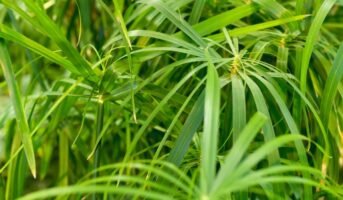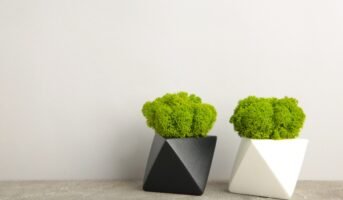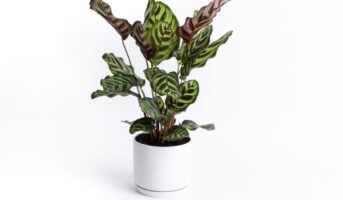Cyperus alternifolius is a low-maintenance houseplant that proliferates. This plant will make an excellent addition to your pond. All they need is adequate lighting and copious amounts of watering.
It is a type of houseplant often called Umbrella Papyrus, Umbrella Plant, or Umbrella Palm. It is a semi-aquatic, grass-like plant that belongs to the sedge family’s huge genus Cyperus. It originated in West Africa, Madagascar, and the Arabian Peninsula but is now found worldwide. Cyperus alternifolius achieved the Garden Merit Award from the British Royal Horticultural Society (RHS).
Cyperus alternifolius can survive the winter if kept indoors and placed near a sunny window. Then, you can put the plant back in the pond when the weather warms up again. The height of the plant provides a calm backdrop for smaller aquatic plants like water lilies. Let’s learn about Cyperus alternifolius maintenance, growing, and much more.
Cyperus alternifolius facts
| Name of the Species | Cyperus alternifolius |
| Taxonomic tree | Domain: Eukaryota
Phylum: Spermatophyta Family: Cyperaceae Genus: Cyperus |
| Plant type | Ornamental Grasses and Sedges, Perennial, Water Plant |
| Distribution | Madagascar, West Africa, and the Arabian Peninsula |
| Other names | Umbrella Plant, Umbrella Sedge |
| Cultural/amenity | Impact- Positive |
| Human health | Impact- Positive |
| Uses | Indoor plants, containers, ponds, Arrangements |
| Temperature range | 10°C (50°F) – 22°C(72°F) |
| Best season for growth | Summer |
| Maintenance | Medium |
Description of Cyperus alternifolius
Cyperus alternifolius is a perennial upright herb that can grow up to 2 meters tall. It includes fibrous roots and a creeping rootstalk. The stem is firm, glabrous, and slightly triangular. At the bottom of the plant, there are four to five extremely short leaves, like sheaths.
As many as 30 linear blades, each around 30 cm long, are arranged in an umbrella-like pattern at the top. It is hairless and has parallel veins, a narrow tip, and a rough edge. A huge umbel of 10 to 20 rays carrying little clusters of leveled, greenish-brown spikelets at their extremities makes up the inflorescence.
The genus
Cyperus
Native habitat
Madagascar, West Africa, and the Arabian Peninsula
Sun tolerance
High
Height
2-4 metre
Leaves
Spirally arranged at the very tip of the stem, the leaf-like structures are actually involucral bracts, with slightly pleated texture
Leave colour
Green to reddish brown
Crown shaft
Crown of leaves at the top
Cold tolerance
Winter hardy to USDA Zone 9
Growth rate
Grows continuously in the hotter months of the year
Fruit
Nut, Seeds endospermic
How to take care of Cyperus alternifolius?

Light: Cyperus alternifolius may thrive in every light condition, including bright sunlight, medium light, light shade, and full sun. In general, it is pretty flexible and accommodating. However, the plant should be shielded from the sun’s rays and strong winds, as exposure to either can harm the bracts.
Water: To keep your Cyperus alternifolius in good shape and lush-looking, you need to give a high degree of water saturation. Hence make an effort to maintain the drip tray filled up every time. You can lessen how often you have to fill a drip tray by selecting one with a high edge.
In contrast to various other houseplants, Cyperus alternifolius’ water needs are non-negotiable, as insufficient watering will swiftly result in unsightly consequences like the appearance of brown spots on the leaves or yellow or brown stems.
However, you can reduce watering in freezing weather as excessive moisture at this point can cause rotting damage. In addition, you must avoid ever submerging the whole pot in water due to the exact cause.
Humidity: If the Cyperus alternifolius plant’s watering needs are being fulfilled, then there won’t be a need for more humidity, as persistent moisture at the plant’s roots will develop a miniature ecosystem that naturally increases the surrounding moisture.
Feeding: Even though Cyperus alternifolius can create a lot of growth, it will certainly not require as much feed. When the plant is actively growing, you will have to feed it once a month at normal strength.
Temperature: Cyperus alternifolius is relatively hardy outside and exhibits the same traits indoors. The ideal temperature range is between 10°C (50°F) to 22°C (72°F).
Cold temperatures down to about four °C (39°F) are desirable for brief periods. However, you must be cautious if it gets too hot as the soil will quickly dry out and require more repeated watering.
Repotting: You should consider repotting your Cyperus alternifolius into a larger pot using a rich loam-holding potting medium whenever it occupies the existing container.
Growth rate of Cyperus alternifolius
When Cyperus alternifolius has access to hot, bright sunshine and enough water, it will grow swiftly. It is excellent if you need something to occupy a space rapidly or are propagating. When winter comes, it tends to be either less active or stop developing altogether.
How to plant cyperus alternifolius?

Several methods for propagating a Cyperus alternifolius include seedlings, division, and cuttings. To multiply by seedlings, you must sow them in moist soil. You will also have to water them regularly so that the seedlings will develop quickly. Another successful way to propagate Cyperus alternifolius is to break the clumps into portions and plant them independently. Finally, the propagation using cutting is regarded as the most structured and dependable method, and numerous ways exist.
The easiest way is to remove the entire plant stem and trim it to close by 4″ inches in length. The next step is to split the leaflets in half and set them inverted in little water jars. The underwater flyers will grow into a new plant stem after a few weeks. Since the new plant stem emerges from the water, it will sprout roots and new leaflets.
Once the new growth stem has established a good set of roots, try removing the cutting from the water, separate the new branch from the previous one, and place it in a pot loaded with potting compost.
You need to water the newly potted plant frequently so it will develop to a great size in a few months. The plant also reproduces by self-seeding under an ideal developing environment. The plant will let you know if conditions are too dim by generating relatively few new shoots.
Uses of Cyperus alternifolius
Cyperus alternifolius is a popular landscaping plant that can be used as a backdrop, accent or integrated into a water feature. It prefers moist soil and thrives in water gardens with moderate shade. It works well as a water plant.
Problems with Cyperus alternifolius
Brown Leaf Tips, Stems, and Yellowing Leaves: While Cyperus alternifolius may tolerate a range of care levels, it will be highly resentful if you don’t provide enough water. Even a little bit of soil drying out can make it irritated. If this goes on for too long, its parts will degrade quickly. Therefore, it is necessary to ensure that the plant container is waterlogged or moist. Finally, you must remove or pluck the stems out of the clump once they have become brown. It can be tedious but weirdly soothing. When the plant is fully green again, it will look much nicer.
Almost Negligible Growth: Cyperus alternifolius grows continuously in the hotter months of the year, so if they suddenly stop growing, you should be aware that something is wrong. The most frequent causes are insufficient light or a cold environment. Your plant may need to be repotted into a larger container with new potting soil or fresh compost.
Plant Pests: Many bugs avoid pretty humid locations; therefore, when something goes wrong, you should be aware that you might be dealing with rotting or disease. However, look for pests like Mealy Bugs and Green or Black Fly if something seems off with your plant.
FAQs
Is Cyperus alternifolius poisonous?
Although a few pet owners reported that they have seen their cats or dogs chewing the leaves of Cyperus alternifolius without any negative consequences. However, leading authorities still rank it as slightly harmful. Furthermore, it indicates that consuming Cyperus alternifolius may produce mild symptoms like vomiting or diarrhea.
How hard is Cyperus alternifolius?
Cyperus alternifolius is not wholly durable but will typically live as long as the crown is submerged in water for 20 cm beneath the ice.
What are the benefits of Cyperus alternifolius for health?
Studies have revealed that Cyperus alternifolius has hepatoprotective, antibacterial, phytoremediation, and antioxidant effects. In Africa, Cyperus alternifolius plant's ash is used to treat wounds, and decoctions are consumed to treat fevers and stomach problems.
Does Cyperus Alternifolius spread quickly?
When conditions are right, Cyperus alternifolius has the potential to become invasive because of its rhizomatous means of spreading.
Is Cyperus alternifolius secure for use by people?
When given orally to mice at levels as much as 5000 mg, the plant did not produce any toxicity or mortality. It demonstrates its safety for human use.
Housing News Desk is the news desk of leading online real estate portal, Housing.com. Housing News Desk focuses on a variety of topics such as real estate laws, taxes, current news, property trends, home loans, rentals, décor, green homes, home improvement, etc. The main objective of the news desk, is to cover the real estate sector from the perspective of providing information that is useful to the end-user.
Facebook: https://www.facebook.com/housing.com/
Twitter: https://twitter.com/Housing
Email: [email protected]











